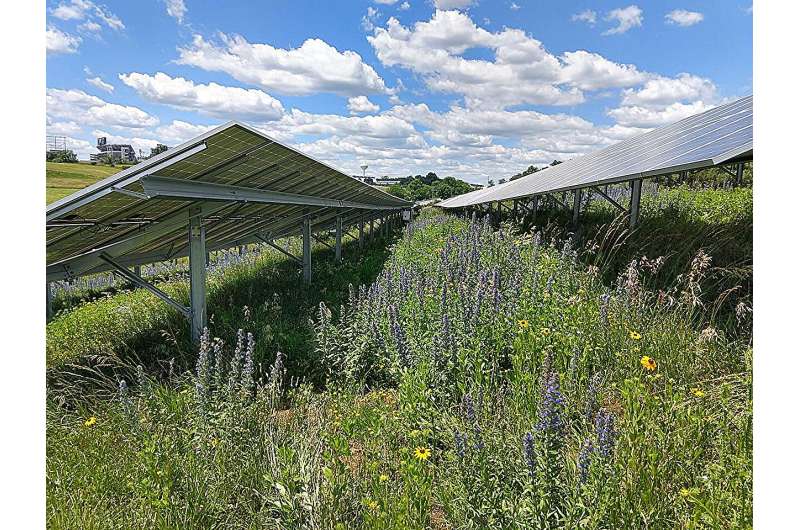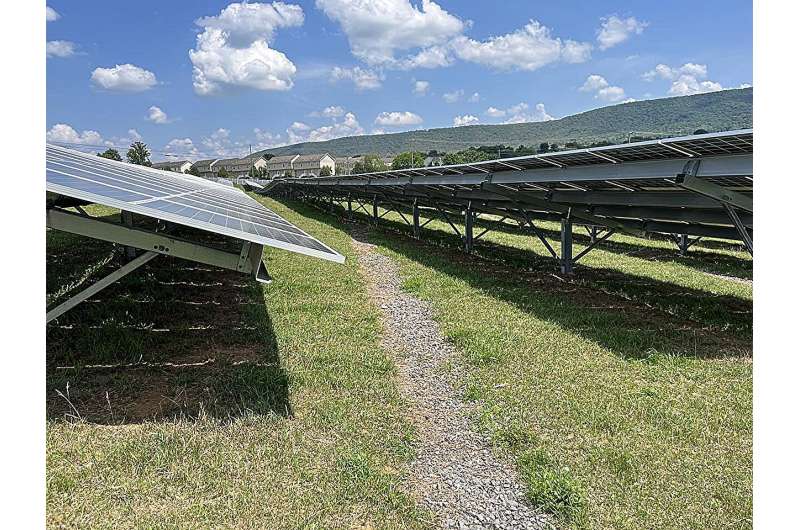This article has been reviewed according to Science X's editorial process and policies. Editors have highlighted the following attributes while ensuring the content's credibility:
fact-checked
trusted source
proofread
Solar farms with stormwater controls mitigate runoff and erosion, study finds

As the number of major utility-scale ground solar panel installations grows, concerns about their impacts on natural hydrologic processes also have grown. However, a new study by Penn State researchers suggests that excess runoff or increased erosion can be easily mitigated—if these "solar farms" are properly built.
Solar panels are impervious to water, and vast arrays of them, it was feared, could increase the volume and velocity of stormwater runoff similar to concrete and asphalt. But after conducting a year-long field investigation of soil moisture patterns, solar radiation and vegetation at two solar farms in central Pennsylvania—built on slopes representative of the Northeast U.S.—the researchers concluded that such installations should not present negative implications for stormwater management.
In findings recently published in Journal of Hydrology, the team reported that healthy vegetation and well-draining soils can help manage runoff on solar farms, and where necessary on more challenging landscapes, engineered stormwater controls can manage any unmitigated runoff.
"We were especially interested in stormwater movement in solar farms on complex terrain and steep slopes," said Lauren McPhillips, assistant professor in civil and environmental engineering, whose research group conducted the study. "There's a lot of concern that solar is eating up prime agricultural land with well-draining soils that are pretty flat. From those sites, you have minimal runoff concerns. We are interested in facilitating making use of more challenging marginal lands for solar farms."
In the study, lead researcher Rouhangiz "Nasim" Yavari, doctoral degree candidate in the Water Resources Engineering Program in the Department of Civil and Environmental Engineering, analyzed soil moisture patterns in the solar farms. They revealed redistribution of water relative to solar panels, with soil moisture under driplines—ground directly beneath the lower edge of the panels from which precipitation falls—19% higher than nearby land, and moisture in the soil under the panels 25% lower than nearby land, on average, at both solar farms over a year.
The researchers noted that there were periods of saturation and localized runoff generation at the panel driplines during heavy precipitation events. However, an open interspace between panel rows and existing infiltration basins and trenches at both solar farms managed the runoff.

Micrometeorological monitoring—assessing the small-scale weather and climate processes that affect things like agriculture, forestry and the natural environment—indicated reduced evapotranspiration, or the process by which water is transferred from the land to the atmosphere, under the panels. The team also found that the potential underpanel evapotranspiration was 37% to 67% lower in summer, with a minimal difference in winter.
A vegetation survey revealed that both solar farms in the study had almost complete ground coverage under panels, which is critical for supporting infiltration and reducing erosion, noted McPhillips, who also is a faculty member in the Department of Agricultural and Biological Engineering in the College of Agricultural Sciences.
This research is the first assessment of structural stormwater management practices on solar farms, and it provides new insights into the hydrological phenomena of the installations through first-hand field measurements, McPhillips pointed out. The study provides some of the first interpretation of saturation and runoff potential on solar farms, in particular on steep and complex landscapes.
"While our observations document clear alteration in natural hydrologic patterns, they also demonstrate that adequately sized vegetated spaces between solar panel rows, and in some cases, structural stormwater management, can manage these changes," she said. "These types of insights, along with investigation of how land management on solar farms can affect other ecosystem services, can allow us to facilitate this critical transition to renewable energy with minimal ecosystem impact."
Ongoing research, McPhillips added, is focusing on computer modeling of these research sites to inform appropriate design of stormwater management practices on solar farms.
Cibin Raj, associate professor of agricultural and biological engineering; Jonathan Duncan, associate professor of hydrology; Margaret Hoffman, assistant professor of landscape contracting; and undergraduate researchers Demetrius Zaliwciw, Katherine Chu and Austin Gaydos contributed to the research.
More information: Rouhangiz Yavari Bajehbaj et al, Quantifying soil moisture and evapotranspiration heterogeneity within a solar farm: Implications for stormwater management, Journal of Hydrology (2024). DOI: 10.1016/j.jhydrol.2024.131474


















